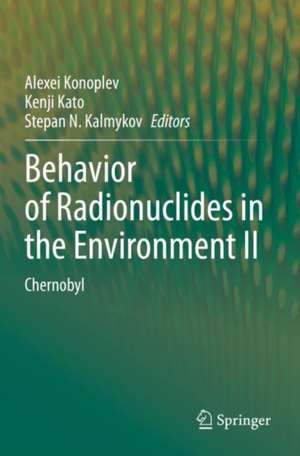Behavior of Radionuclides in the Environment II: Chernobyl
Editat de Alexei Konoplev, Kenji Kato, Stepan N. Kalmykoven Limba Engleză Paperback – 20 mai 2021
Lessons learned from long-term research on the environmental behavior of radionuclides can help us understand the pathways of environmental contamination, which, in turn, will allow us to improve methods for modeling and predicting the long-term effects of pollution.
This book features a wealth of original data and findings, many of which have never been published before, or were not available internationally. The contributing authors are experts from Ukraine, Russia and Belarus with more than 30 years of experience investigating Chernobyl-derived radionuclides in the environment.
The content presented here can help to predict the evolution of environmental contamination following a nuclear accident, and specifically the Fukushima Dai-ichi nuclear power plant accident.
| Toate formatele și edițiile | Preț | Express |
|---|---|---|
| Paperback (1) | 737.43 lei 3-5 săpt. | |
| Springer Nature Singapore – 20 mai 2021 | 737.43 lei 3-5 săpt. | |
| Hardback (1) | 1011.27 lei 3-5 săpt. | |
| Springer Nature Singapore – 20 mai 2020 | 1011.27 lei 3-5 săpt. |
Preț: 737.43 lei
Preț vechi: 899.30 lei
-18% Nou
Puncte Express: 1106
Preț estimativ în valută:
141.10€ • 147.86$ • 116.65£
141.10€ • 147.86$ • 116.65£
Carte disponibilă
Livrare economică 21 martie-04 aprilie
Preluare comenzi: 021 569.72.76
Specificații
ISBN-13: 9789811535703
ISBN-10: 9811535701
Pagini: 443
Ilustrații: X, 443 p. 145 illus., 79 illus. in color.
Dimensiuni: 155 x 235 mm
Greutate: 0.73 kg
Ediția:1st ed. 2020
Editura: Springer Nature Singapore
Colecția Springer
Locul publicării:Singapore, Singapore
ISBN-10: 9811535701
Pagini: 443
Ilustrații: X, 443 p. 145 illus., 79 illus. in color.
Dimensiuni: 155 x 235 mm
Greutate: 0.73 kg
Ediția:1st ed. 2020
Editura: Springer Nature Singapore
Colecția Springer
Locul publicării:Singapore, Singapore
Cuprins
Part 1 Atmospheric transport of radionuclides and resuspension .- 1. Atmospheric transport of radionuclides initially released as a result of the Chernobyl accident.- 2. Re-entrainment of the Chernobyl-derived radionuclides in air. Experimental data and modelling.- Part 2 Behavior of Chernobyl-derived radionuclides in soil-water.- 3. Mobility and bioavailability of Chernobyl-derived radionuclides in soil-water environment – Review.- 4. Quantitative assessment of lateral migration of Chernobyl-derived 137Cs in contaminated territories of the East European Plain.- Part 3 Behaviour of radionuclides in agricultural and forest ecosystems.- 5. Behavior of Chernobyl-derived radionuclides in agricultural ecosystems.- 6. Behavior of the Chernobyl-derived radionuclides in forest ecosystems and effects of radiation.- Part 4 Behaviour of radionuclides in aquatic ecosystems.- 7. Long-term dynamics of Chernobyl-derived radionuclides in rivers and lakes.- 8. Distribution and dynamics of radionuclidesin the Chernobyl Cooling Pond.- 9. Radioactivity Of Aquatic Biota In Water Bodies Impacted With Chernobyl-Derived Radionuclides.
Notă biografică
Alexei Konoplev
Fukushima University
Institute of Environmental Radioactivity
Fukushima
Japan
alexeikonoplev@gmail.com
Kenji Kato
Shizuoka University
Faculty of Science
Shizuoka
Japan kato.kenji@shizuoka.ac.jp
Stepan N. Kalmykov
Lomonosov Moscow State University
Radiochemistry Division
Moscow Russia
Stepan_5@hotmail.com
Fukushima University
Institute of Environmental Radioactivity
Fukushima
Japan
alexeikonoplev@gmail.com
Kenji Kato
Shizuoka University
Faculty of Science
Shizuoka
Japan kato.kenji@shizuoka.ac.jp
Stepan N. Kalmykov
Lomonosov Moscow State University
Radiochemistry Division
Moscow Russia
Stepan_5@hotmail.com
Textul de pe ultima copertă
This is Volume II in a three-volume set on the Behavior of Radionuclides in the Environment, focusing on Chernobyl. Now, so many years after the Chernobyl accident, new data is emerging and important new findings are being made. The book reviews major research achievements concerning the behavior of Chernobyl-derived radionuclides, including their air transport and resuspension, mobility and bioavailability in the soil-water environment, vertical and lateral migration in soils and sediments, soil-to-plant and soil-to-animal transfer, and water-to-aqueous biota transfer. The long-term dynamics of radionuclides in aquatic ecosystems are also discussed, in particular, the heavily contaminated cooling pond of the Chernobyl Nuclear Power Plant, which is in the process of being decommissioned.
Lessons learned from long-term research on the environmental behavior of radionuclides can help us understand the pathways of environmental contamination, which, in turn, will allow us to improve methods for modeling and predicting the long-term effects of pollution.
This book features a wealth of original data and findings, many of which have never been published before, or were not available internationally. The contributing authors are experts from Ukraine, Russia and Belarus with more than 30 years of experience investigating Chernobyl-derived radionuclides in the environment.
The content presented here can help to predict the evolution of environmental contamination following a nuclear accident, and specifically the Fukushima Dai-ichi nuclear power plant accident.
Lessons learned from long-term research on the environmental behavior of radionuclides can help us understand the pathways of environmental contamination, which, in turn, will allow us to improve methods for modeling and predicting the long-term effects of pollution.
This book features a wealth of original data and findings, many of which have never been published before, or were not available internationally. The contributing authors are experts from Ukraine, Russia and Belarus with more than 30 years of experience investigating Chernobyl-derived radionuclides in the environment.
The content presented here can help to predict the evolution of environmental contamination following a nuclear accident, and specifically the Fukushima Dai-ichi nuclear power plant accident.
Caracteristici
Focuses on various aspects of the long-term behavior of Chernobyl-derived radionuclides Offers readers a better understanding of the mechanisms of radionuclide migration in the environment Shares the latest findings
